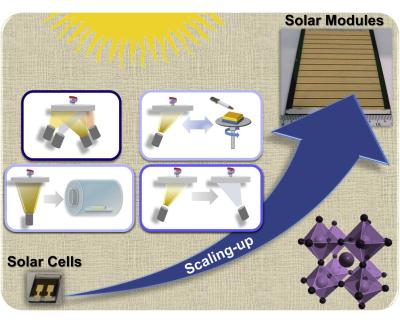Perovskite-Info weekly newsletter
Published: Tue, 01/03/23
The Perovskite-Info newsletter (January 3, 2023)
Cannot read this? View it online here
EPFL team uses unique modulators to improve the efficiency and stability of perovskite solar cells
A team of researchers at EPFL have developed a method that improves both power conversion efficiency and stability of solar cells based on pure iodide as well as mixed-halide perovskites. The new method aslo suppresses halide phase segregation in the perovskite material. The research was carried out by the groups of Professors Michael Grätzel and Ursula Rothlisberger at EPFL and led by Dr Essa A. Alharbi and Dr Lukas Pfeifer.
The method treats perovskite solar cells with two alkylammonium halide modulators that work synergistically to improve solar cell performance. The modulators were used as passivators, compounds used to mitigate defects in perovskites, which are otherwise promoting the aforementioned degradation pathways.
EPFL team use unique modulators to improve the efficiency and stability of perovskite solar cells
A team of researchers at EPFL have developed a method that improves both power conversion efficiency and stability of solar cells based on pure iodide as well as mixed-halide perovskites. The new method aslo suppresses halide phase segregation in the perovskite material. The research was carried out by the groups of Professors Michael Grätzel and Ursula Rothlisberger at EPFL and led by Dr Essa A. Alharbi and Dr Lukas Pfeifer.
The method treats perovskite solar cells with two alkylammonium halide modulators that work synergistically to improve solar cell performance. The modulators were used as passivators, compounds used to mitigate defects in perovskites, which are otherwise promoting the aforementioned degradation pathways.
Tokyo government to launch research on perovskite solar cells
Reports suggest that the Tokyo metropolitan government will start joint research with a major Japanese chemical maker on perovskite-based solar cells, that are film-thin, lightweight and bendable, as part of its efforts to promote the use of renewable energy.
The metropolitan government expects that the next-generation solar cells, due to their characteristics, can be used in a wider range of locations compared with current mainstream solar panels.
Researchers investigate methods for thermal evaporation and hybrid deposition of perovskite solar cells and mini-modules
Researchers from Singapore's Nanyang Technological University have examined how thermal evaporation (TE) could be used to fabricate mini perovskite solar modules. TE are mature techniques that are commonly used in the microelectronic and optoelectronic industries to produce organic light-emitting diodes (OLEDs), metal contacts, and various coatings.
The research team analyzed the use of several evaporation-based techniques to fabricate halide perovskite thin films, from the relatively simple single-source deposition and multi-source co-evaporation to the more complex multistep evaporation and hybrids of thermal evaporation with gas reaction and solution processing. The team explained that this combined approach exploits the advantages of both methods, but also has some limitations, such as increased complexity and the use of solvents.
Metalgrass LTD
9 Har Tsin St.
Kfar Sava Hasharon 4430809
ISRAEL
Unsubscribe | Change Subscriber Options






